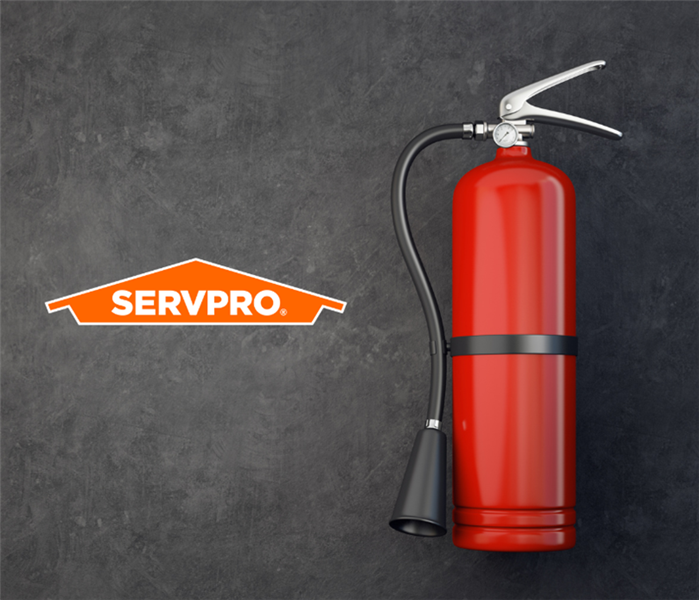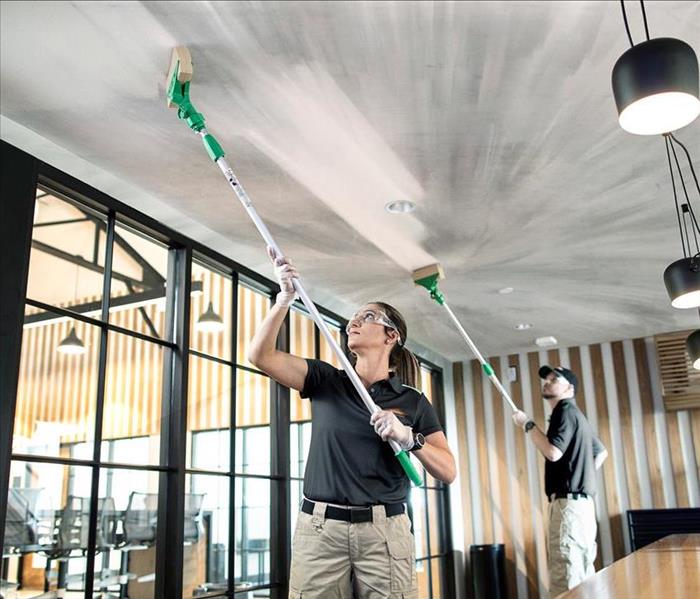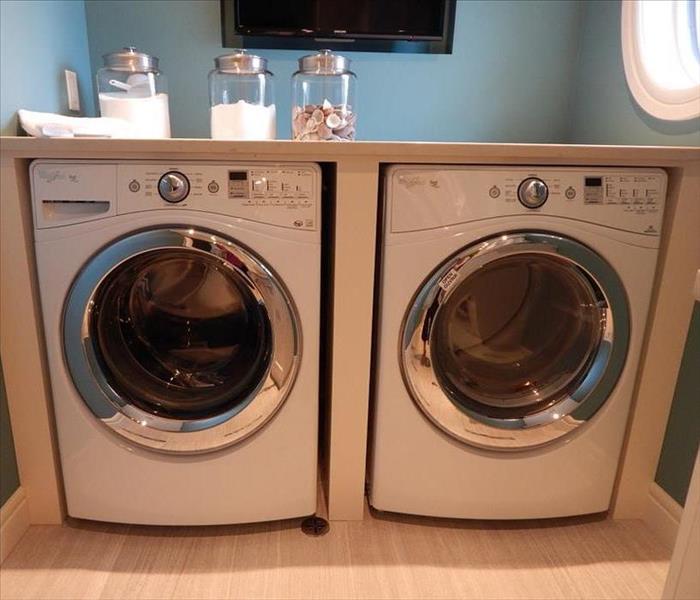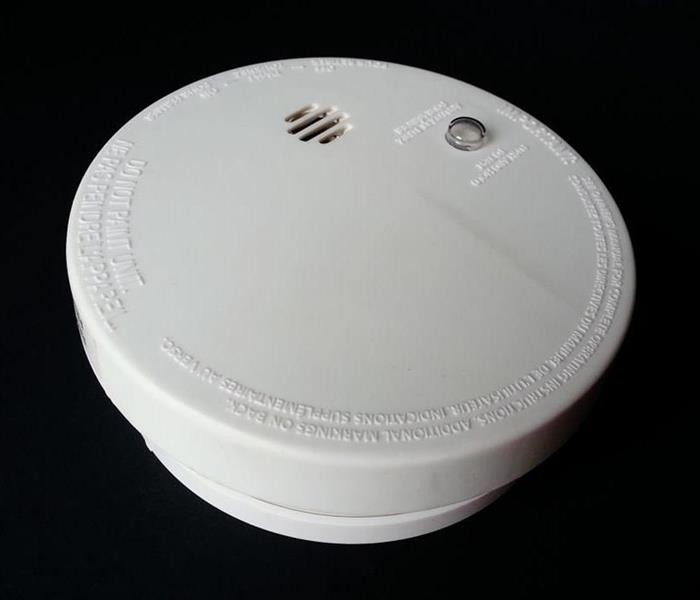Recent Fire Damage Posts
Fire Extinguishers - What's your Type?
5/5/2023 (Permalink)
 SERVPRO knows that fire extinguishers help save lives.
SERVPRO knows that fire extinguishers help save lives.
Fire extinguishers – What’s your type?
There are 5 types of fire extinguishers rated for different types of fires. Knowing the ratings of the extinguishers could be the difference between life and death when it comes to a home fire. There are 5 classes; A, B, C, D and K.
A Class A extinguisher is a water or water mist spray. Best used for carbon materials such as wood, textiles or paper. The label on a class A extinguisher will be a triangle with an ‘A’ inside and if color coded, will be green.
A Class B extinguisher sprays a film forming foam that aids in keeping a fire from reigniting. This line of defense is recommended for flammable liquids such as oil, oil-based paints, tar, etc. The label on a class B extinguisher will be square with the letter ‘B’ inside and if color coded, it will be red.
A Class C extinguisher is a carbon dioxide spray that is used to extinguish a live electrical fire. These extinguishers will smother the fire without the danger of electrical shock. The label on a class C extinguisher will be a circle with a ‘C’ inside and if color coded, it will be blue.
A Class D extinguisher is a dry powder spray and is specific to the combustible metal that is being dealt with. The label on a class D extinguisher will be a five-point star with a ‘D’ inside and if color coded, it will be yellow.
A Class K extinguisher is specific to kitchen fires, extinguishing cooking oil, animal oil and high temperature fats. The label on a class K extinguisher will be a hexagon with a ‘K’ inside and if color coded, it will be black.
Knowing the types of fire extinguishers that should be used on specific types of fires can be a life saver. But, if you experience a fire disaster in your home or commercial property, SERVPRO Duncanville/Desoto is always ready to help. We are available 24/7 to respond to your emergency and help you get back to ‘Like it Never Happened’.
Smoke Alarms Save Lives
4/6/2023 (Permalink)
 Smoke alarms save lives.
Smoke alarms save lives.
What is the best way to protect your home and family against a house fire? According to the National Fire Protection Association (NFPA), smoke alarms are the best offense in fire protection when installed and used properly.
All smoke alarms in your home should be tested once a month to ensure they are in working condition. To test an alarm you will push the push the "TEST" button. Smoke alarms with non-replaceable batteries should be replaced every ten years. For smoke alarms with replaceable batteries, it's advised to switch the batteries out annually, and replace the entire unit every ten years. A few suggestions to timing in switching batteries in the alarms would be to do it on the first day of spring or daylight savings. When the alarm begins to chip because of low battery, make it a priority to replace the battery as soon as possible. Never disarm or remove a battery completely from a smoke alarm. In almost 50% of fires where smoke alarms were present, but did not function properly, this was due to a removed or disconnected battery.
Take a look around your home to make sure the smoke detectors are located in the correct places for maximum protection. There should be one alarm in every bedroom, outside of each bedroom and one on each level, at minimum. For larger homes, more smoke alarms may be required. If you are unsure about installing or testing your smoke alarms, an electrician or your local fire department can assist.
Be sure that your household has a plan in place in the event of a fire emergency. Practice fire drills with your family regularly, to ensure that all family members are aware of what to do in case of a fire. Talk with your family about a designated area outside of your home to use as a meeting place in the event of a fire evacuation.
Winter Weather and Fire Hazards
2/21/2023 (Permalink)
 If Fire Damage happens, SERVPRO can help
If Fire Damage happens, SERVPRO can help
In winter months, the objective is to keep our home and family warm. However, the luxuries that help provide this warmth can also cause a fire disaster. Do you know what to watch for?
Heating equipment, like space heaters account for half of all fires caused by heating homes between December and February. When in use, space heaters and other heating equipment should be kept at least 3 feet from any flammable material.
A fireplace is a wonderful source of heat during the winter, but also poses a fire risk. To lower the fire potential, check the chimney to make sure there are no clogs and keep all flammable material at least 3 feet from the hearth.
The number one cause of house fires comes from the kitchen. Cooking. We seem to do a lot of that during the winter season. The best way to keep these kitchen fires from happening is to stay in the kitchen while cooking, and to stay vigilant and alert.
Even with the best of precautions, disasters happen. If this happens in your home, SERVPRO Duncanville/Desoto has the expert training and experience to undo the damage left at your home or commercial property due to a fire damage. Call us today and let us get your home back to 'Like It Never Happened' condition.
Dryer Fire Risk
4/29/2019 (Permalink)
 Reduce the risk of fire by having SERVPRO of Duncanville/DeSoto clean out your ducts and dryer vent.
Reduce the risk of fire by having SERVPRO of Duncanville/DeSoto clean out your ducts and dryer vent.
The Federal Emergency Management Agency cites that 34% of home dryer fires are caused by the dryer vents not being cleaned.
$35 million annually in property loss is caused by dryer fires. One way to prevent these types of fires is by calling SERVPRO of Duncanville/DeSoto to thoroughly remove dryer lint in the vent and/or air ducts.
The National Fire Protection Agency advises that you clean the lint filter before and after each load, and regularly check to ensure that the outdoor vent flap is not blocked by a bird's nest or other obstacle.
To get an estimate, or schedule a cleaning of your dryer vent and ducts, contact SERVPRO of Duncanville/DeSoto at 972-224-8800 24 hours a day, 7 days a week, 365 days a year.
Smoke Alarms Can Save Your Life
4/26/2019 (Permalink)
 Smoke alarms are crucial in helping protect your home and business from fire damage.
Smoke alarms are crucial in helping protect your home and business from fire damage.
According to the National Fire Protection Association (NFPA), smoke alarms save lives when properly installed and maintained.
At a minimum, there should be a smoke alarm in every bedroom in your home, outside of each sleeping area, and on each level. Additional alarms may be required in larger houses.
To maintain your smoke alarm, test each one on a monthly basis by pushing the "TEST" button. Smoke alarms with non-replaceable batteries should be replaced every decade. For smoke alarms with replaceable batteries, it's advised to switch the batteries out annually, and replace the entire unit every ten years. In the event of a chirp alerting you to a low battery level, take immediate action to replace the old battery with a new one; never disable or completely remove a battery from a smoke alarm. In almost 50% of fires where smoke alarms were present, but did not function properly, this was due to a removed or disconnected battery.
If you require assistance to check, maintain, or replace your smoke detectors, contact your local fire department or an electrician.
Be sure that your household has a plan in place in the event of a fire emergency. Practice fire drills with your family regularly, to ensure that all family members are aware of what to do in case of a fire.
The Benefits of Portable Fire Extinguishers
4/26/2019 (Permalink)
 Portable fire extinguishers are essential tools in fire damage prevention.
Portable fire extinguishers are essential tools in fire damage prevention.
When utilized properly, portable fire extinguishers can be essential tools to help save lives and property.
The most effective way to be prepared is to prepare. Begin by reading the instructions on the extinguisher, and familiarize yourself with the directions prior to an actual emergency.
A helpful acronym the National Fire Protection Agency (NFPA) suggests to remember when operating a fire extinguisher is PASS:
P - Pull the pin. Hold the nozzle pointing away from you and release the locking mechanism.
A - Aim low. Point the extinguisher at the base of the fire.
S - Squeeze the lever slowly and evenly.
S - Sweep the nozzle from side to side.
It's important to note that not all fire extinguishers are good to use on all fires. When selecting your extinguishers, read the label closely to ensure you get the ideal one for the area you're going to be keeping it.




 24/7 Emergency Service
24/7 Emergency Service





